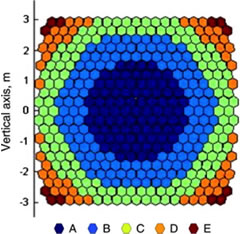Mostrando artículos por etiqueta: Journal of Renewable and Sustainable Energy
Assesment of a Polymeric Reflective Coating for High Concentration Point Focus Applications
D. Riveros-Rosas, R. Castrejón-García, C. A. Arancibia-Bulnes, C. A. Pérez-Rábago, C. A. Estrada-Gasca
Abstract

A methodology for the evaluation of the specularity error of a polymeric filmoptical coating is presented. The methodology is based on the comparison of images from the sun produced by two high quality spherical mirrors, one covered with a highly specular evaporated aluminumfilm, and the second one with the polymeric film under study. This film is a commercial product known as Reflectech®. To determine the specularity error, both images are reproduced by means of ray tracing optical simulations. Those simulations use the angular brightness distribution from the sun as input, which were recorded by means of a specially developed solar scope. Significant differences are obtained between images of the sun generated by both mirrors. However, the specularity error of the coating under consideration is found to be just 0.71 mrad. This error is quite small making the polymeric coating highly appropriate for point focus concentration systems. This is illustrated by calculations for a parabolic dish concentrator.
Assesment of a Polymeric Reflective Coating for High Concentration Point Focus Applications
Radiative heat transfer analysis of a directly irradiated cavity-type solar thermochemical reactor by Monte-Carlo ray tracing
H.I., Villafán-Vidales, Abanades, S., Arancibia-Bulnes, C.A., Riveros-Rosas, D., Romero-Paredes, H., Espinosa-Paredes, G., Estrada, C.A.
Abstract
Radiative heat transfer in a 1 kW cavity-type solar reactor devoted to the thermal reduction of compressed ZnO and SnO2 powders is analyzed by a Monte Carlo ray tracing simulation. The developed model takes into account the radiative properties of the reactant particles and of the ceramic cavity walls, as well as the angular intensity distribution of the incoming concentrated solar irradiation. The model also includes the conduction heat losses through the lateral walls and the energy consumed by the endothermic chemical reaction. It is used to predict the temperature and the absorbed flux density profiles on the inner cavity walls for different main features of the reactor, concerning the dimensions of the cavity and the type of reactant. Results show that the absorbed flux density profile and the theoretical thermochemical efficiency change with the cavity aspect ratio and with the oxide reactant. The cavity with an aspect ratio of 3 and a SnO2 pellet undergoing dissociation presents the highest thermochemical efficiency. Additionally, a different configuration of the reactor design is considered, which consists in implementing a layer of reactive particles on the inner lateral cavity wall. The model highlights that this type of reactor operation with a reactant layer on the lateral cavity wall results in an improved thermochemical efficiency.
Heliostat image drift behavior for different error sources
Martha Escobar-Toledo, Camilo A. Arancibia-Bulnes, Cuitlahuac Iriarte-Cornejo, Julio Waissman, David Riveros-Rosas , Rafael E. Cabanillas and Claudio A. Estrada.
Abstract
Drift is ubiquitous in heliostat fields, and may be caused by diverse geometrical inaccuracies during heliostat installation and operation. This phenomenon is studied for three important primary errors in the present paper: Angular offset in the drive mechanism, pedestal tilt, and canting error. Each error produces characteristic signatures, but there is a diversity of behavior depending on the error parameters and location of the heliostat. The variation of the extent of drift curves is studied as a function of distance, for fixed error parameters. It is found that, in general, this extent is not proportional to distance, except for far heliostats, and depends on a complicated manner on the different parameters involved. Moreover, even though the extent of drift curves becomes proportional to distance for far heliostats, the convergence is very slow, and very variable with the error parameters.
Improving parabolic trough mirror module qualification by FOCuS tool
Manuel I. Peña-Cruz, Camilo A. Arancibia-Bulnes, Ana Monreal Vidal, and Marcelino Sánchez González.
Abstract
An improved tool for the shape qualification of parabolic trough mirror modules used in concentrated solar power plants was developed. The tool is based on the fringe reflection theory, in which sinusoidal fringe patterns are projected on a screen and their reflection over a specular surface is recorded by a camera. The observed distortions in the image are related directly to surface deviations from ideal geometry. Relevant aspects of the technique are its high spatial resolution (more than 1 × 106 points per mirror facet), short measurement time and easy setup. The developed tool (called FOCuS) is capable of calculating the local mirror slope deviations from its ideal design and the RMS value as a quality factor. Furthermore, the tool generates a file which can be loaded into CENER's TONATIUH ray tracing software, through a specially developed plug-in, for mirror modeling and intercept factor calculation with several tube absorber geometries.
Improving parabolic trough mirror module qualification by FOCuS tool
